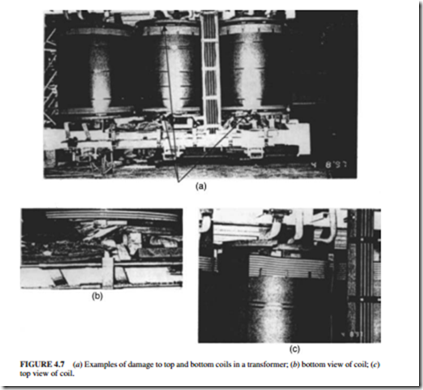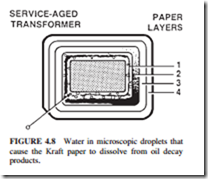FORCES
During normal operation, the axial and radial forces between the windings are moderate. These forces become severe during a short circuit. The transformer must be able to with- stand fault conditions. This includes forces 10 times higher than normal. Figure 4.7 illustrates damaged top and bottom coils in a transformer.
CAUSE OF TRANSFORMER FAILURES
Most transformers fail due to mechanical reasons. The windings are subjected to physical forces that operate in all directions. These forces can become astronomical under short-circuit conditions. For example, a 16-MVA transformer will develop a 500,000-lb vertical force
and a hoop force (horizontal) of 3,000,000 lb. Therefore, the windings must be braced to withstand these forces. If the windings are not properly braced, physical movement occurs. Short circuit is developed, leading to transformer failure. Therefore, the root cause of electrical faults is mechanical in nature.
When the Kraft paper is impregnable with a good, clean, dry oil, it becomes one of the best dielectrics known in industry. Water has devastating effects on Kraft paper. Most transformers fail due to the presence of water. The water that weakens the Kraft paper is the microscopic droplets formed by paper degradation and oil oxidation (Fig. 4.8). The water droplets are produced by the inner layers of paper and oil that is trapped between the coil (copper or aluminum) and the paper. The water acts as a solvent to dissolve and weaken the paper by destroying the fiber of the Kraft paper. This results in loosening the windings. The paper insulation will get abraded by the constant moving of the windings. A total failure is created by having a failure in an extremely small amount of the paper in the transformer. Adequate measures must be taken early, and promptly to protect the transformer.
The water generated in the “innards of the transformer” that causes the destruction of the unit is significantly below the level of detection through oil test procedures and/or electrical testing. Therefore, advanced deterio- ration would have already occurred by the time the evidence appeared in the test data. A suitable solution involves continuous dehydration of the transformer during nor- mal operation. A less expensive solution involves servicing the transformer every 3 to 5 years.
The amount of moisture in the paper of a transformer is expressed as percent mois- ture by dry weight (%M/dw). The aging factor is controlled by controlling the%M/dw. The upper limit of 0.5 %M/dw should be specified when a transformer is selected. If this limit is not specified, the moisture content could be as high as 1.5 to
Figure 4.9 illustrates the aging factor versus %M/dw. As shown, moisture weakens the Kraft paper. This weakening is measured and expressed by the aging factor (AF). Notice the significant increase of the AF with %M/dw. Figure 4.10 illustrates the significant decrease in transformer life expectancy with %M/dw.
Most transformers fail at the bottom due to high %M/dw. This is caused by the fact that paper has up to 3000 times higher affinity for water than oil does at lower temperatures.

